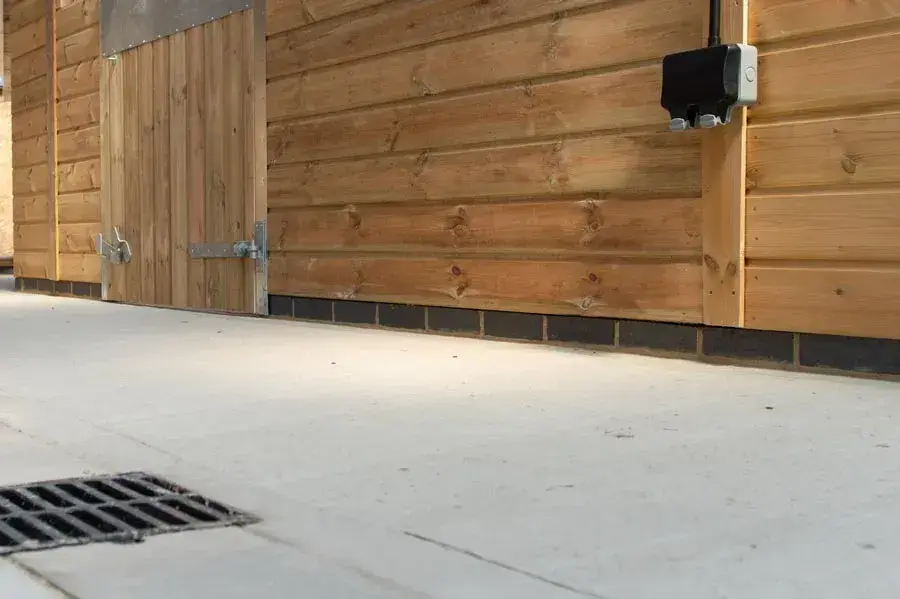
To build fixed stables on your property, you must lay a concrete base first. A level, solid base will ensure the stables have structural integrity, keeping your horses safe. On the other hand, mobile field shelters do not need foundations, as you have to move them every six to eight weeks.
At Chart Stables, we install fixed stables over a concrete base with a single course of semi-engineering bricks.

This article explains everything you need to know to lay stable foundations appropriately. But first, it is important to clarify why stables need to be built on a concrete base.
Fixed horse stables need foundations to prevent sinking in changing ground conditions and withstand storms. Without a solid base, part of the wooden structure could sink into the ground, compromising the integrity of the building.
A stable's base also acts as a waterproof barrier, helping prevent wood rot and improving the structure's lifespan.
For these reasons, it is vital to lay solid foundations before installation.
Most high-quality wooden stables are built on concrete foundations because they provide stability and durability. A concrete base can withstand heavy loads and resist shifting over time.
To lay concrete foundations for your stables, you will need the following materials:
We recommend using an equine or agricultural concrete mix. This mix contains more concrete and extra additives to protect the concrete from horse urine and challenging weather conditions.
The DPC membrane keeps the concrete dry, while the steel mesh increases its stability and prevents it from cracking.
Semi-engineering bricks protect the base from rainwater, keeping it dry. They are the best choice because they are non-porous, which means they are less prone to crumbling and breaking in harsh weather conditions.
Laying a concrete base is a simple process requiring the utmost precision - the foundations must be perfectly level. For this reason, it is vital to follow a detailed base plan.
Here are the 6 steps to laying stable foundations.
First, scrape off all vegetation and remove any rocks and roots from the area. At this stage, you do not need to be precise; simply clear an area larger than the concrete slab size detailed on the base plan.
You can then mark the area on the ground using pegs and strings. Make sure it accurately reflects the base plan.
Next, dig about 10 inches (25cm) into the ground. You might need to dig deeper for more extensive stables. Once you’ve dug the whole area out, compact the soil to make the surface even. We recommend using a plate compactor or a hand tamper for this task.
Install formwork. Secure timber planks around the perimeter and drive wooden posts in the ground every metre or so to prevent the planks from bowing.
Before you pour the concrete over the area, lay the hardcore. Shovel it into the dug-out area and use a manual earth rammer or a powered wacker plate to compact it. Quantities vary depending on the size of your foundations; the base should consist of 6 inches (15.24cm) of compacted hardcore.
To keep moisture out of the concrete slab, lay a DPC membrane between the hardcore and the concrete. Next, lay steel mesh, ensuring you raise it off the hardcore.
Once you have compacted the hardcore, you can mix the concrete and pour it over it. The quantity of concrete will depend on the size of your stables; we recommend a slab made of 6 inches (15.24cm) of equine concrete mix.
Smooth the concrete over using a straight-edged wooden piece so it is flat. Ensure it slopes slightly towards the front or back to allow for drainage.
Finally, you can lay the bricks. These need to be laid level and square. Make sure you leave half brick gaps for drainage.

It is not always possible to lay the concrete base perfectly flat. You can adjust the brickwork to provide a level base if that is your case.
The concrete and brickwork need about a week to cure, so you must ensure the groundworks are completed at least seven days before your agreed installation date. If your foundations are delayed, you will need to reschedule the installation.
It is crucial the groundworks are carried out to a high standard so the structure is solid and lasts over time in challenging weather conditions.
For this reason, at Chart Stables, we recommend hiring a knowledgeable professional to lay the concrete base.
If you’re interested in one of our wooden fixed stables, we can help you prepare the stable foundations. We offer unlimited advice over the phone to provide you with all the information you need, including a base plan, to lay the perfect base.

Our wooden stables are made of sustainably sourced pressure-treated timber. Our standard service includes design, delivery, and installation. If you prefer to assemble the stables yourself, you can save 20% off the purchase price. We deliver and install all over the UK.








